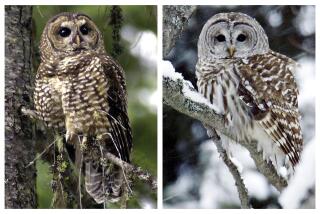P.V. Estates : Bird-Trapping Halt Urged
A private study of city peafowl has concluded that some male birds could be removed without endangering the bird population, but it calls for a moratorium on the trapping of female birds until there is evidence that the flock is regenerating.
Martin G. Rigby, an Orange County environmental scientist who did the study for the Friends of the Peacocks citizens group, said all trapping must be closely controlled and no trapping of any kind should be permitted between April and August, when chicks are with their mothers.
The Friends commissioned the study--aimed at determining the number of birds needed to maintain the city’s two flocks--after deciding not to pursue legal opposition to a city plan that permits residents who object to the birds to trap and remove them from private property. Birds may be relocated to a wildlife sanctuary outside the city until the flocks have been reduced to 25 birds.
However, Rigby, who formerly lived in one of the city’s peafowl areas, said both flocks--in Espinosa Circle and near the Malaga Cove library--have a “precariously low” number of females because past trapping has ignored the sex and age of birds. Younger birds that perpetuate the flocks are more likely to be trapped than older ones who, he said probably are “trap-shy.” He said the Espinosa Circle peafowl population is “already at or below a biological minimum necessary to perpetuate the species.”
Rigby called for the addition of six to seven new female birds to the library flock. At the same time, he said the Espinosa Circle flock could be reduced by six to seven male birds, but females should be left untouched. Since it is the males who make the shrill noises at night, Rigby said, reducing the number might lessen complaints.
In a survey on May 11, Rigby observed 38 birds in the Espinosa Circle area. However, there were no young birds. The flock near the Malaga Cove library numbered 13 but Rigby said the number probably was underestimated and is closer to 30 birds.
The study was given to the city by the Friends of the Peacocks.
More to Read
Sign up for Essential California
The most important California stories and recommendations in your inbox every morning.
You may occasionally receive promotional content from the Los Angeles Times.










